| Image | Value | Technical parameters | Description | Date of | Dated years of issue |
|---|
| Obverse | Reverse | Diameter | Mass | Composition | Obverse | Reverse | Edge | First issue | Withdrawal |
|---|
 |  | Half penny (½d) | 25.5 mm | 5.67 g | Bronze (97% copper, 2.5% zinc, 0.5% tin) | Portrait of King George V. Designed by Sir E. B. Mackennal. | At centre within a circle of beads, the denomination "ONE HALF PENNY" in three lines above a plain scroll; around the circle of beads, "COMMONWEALTH OF AUSTRALIA" and date. Designed by W. H. Blackmore. | Plain | 1911 | 14 February 1966 | 1911–1936 |
 | Portrait of King George VI. Designed by Thomas H. Paget. | 1938 | 1938–1939 |
 | Kangaroo facing right, "AUSTRALIA" above and "HALF PENNY" below, date above denomination. Designed by George Kruger Gray. | 1939 | 1939–1952 |
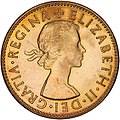 | Portrait of Queen Elizabeth II. Designed by Mrs Mary Gillick. | 1953 | 1953–1955, 1959–1964 |
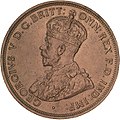 | 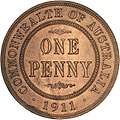 | Penny (1d) | 30.8 mm | 9.45 g | Portrait of King George V. Designed by Sir E. B. Mackennal. | At centre within a circle of beads, the denomination "ONE PENNY" in three lines above a plain scroll; around the circle of beads, "COMMONWEALTH OF AUSTRALIA" and date. Designed by W. H. Blackmore. | 1911 | 1911–1936 |
 |  | Portrait of King George VI. Designed by Thomas H. Paget. | Kangaroo facing left, "AUSTRALIA" above and "PENNY" below, date above denomination. Designed by George Kruger Gray. | 1938 | 1938–1952 |
 | Portrait of Queen Elizabeth II. Designed by Mrs Mary Gillick. | 1953 | 1953, 1955–1964 |
 |  | Threepence (3d) | 16 mm | 1.41 g | Sterling silver (92.5% silver, 7.5% copper) | Portrait of King Edward VII. Designed by George W. De Saulles. | At centre, 1908 Australian coat of arms. Motto in the ribbon "ADVANCE AUSTRALIA", "THREEPENCE" above and date between arrow heads below. Designed by W. H. Blackmore. | 1910 | 1910 |
 | Portrait of King George V. Designed by Sir E. B. Mackennal. | 1911 | 1911–1912. 1914–1928, 1934–1936 |
 |  | Portrait of King George VI. Designed by Thomas H. Paget. | Three ears of wheat held by a curved ribbon, AUSTRALIA", below divided into two by the stalks of the wheat "THREE PENCE", above, across the middle of the coin the date divided into two by the ears. Designed by George Kruger Gray. | 1938 | 1938–1944 |
| 50% silver, 40% copper, 5% zinc, 5% nickel | 1947 | 1947–1952 |
 | Portrait of Queen Elizabeth II. Designed by Mrs Mary Gillick. | 1953 | 1953–1964 |
 |  | Sixpence (6d) | 19 mm | 2.83 g | Sterling silver (92.5% silver, 7.5% copper) | Portrait of King Edward VII. Designed by George W. De Saulles. | At centre, 1908 Australian coat of arms. Motto in the ribbon "ADVANCE AUSTRALIA", "SIXPENCE" above and date under the crest below. Designed by W. H. Blackmore. | Redded | 1910 | 1910 |
 | Portrait of King George V. Designed by Sir E. B. Mackennal. | 1911 | 1911–1912, 1914, 1916–1928, 1934–1936 |
 | Portrait of King George VI. Designed by Thomas H. Paget. | 1938 | 1938–1945 |
| 50% silver, 40% copper, 5% zinc, 5% nickel | 1946 | 1946, 1948, 1950–1952 |
 | Portrait of Queen Elizabeth II. Designed by Mrs Mary Gillick. | 1953 | 1953–1963 |
 |  | Shilling (1/-) | 23.5 mm | 5.65 g | Sterling silver (92.5% silver, 7.5% copper) | Portrait of King Edward VII. Designed by George W. De Saulles. | At centre, 1908 Australian coat of arms. Motto in the ribbon "ADVANCE AUSTRALIA", "ONE SHILLING" above and date under the crest below. Designed by W. H. Blackmore. | 1910 | 1910 |
 | Portrait of King George V. Designed by Sir E. B. Mackennal. | 1911 | 1911–1922, 1924–1928, 1931, 1933–1936 |
|  | Portrait of King George VI. Designed by Thomas H. Paget. | Ram's head facing left, "AUSTRALIA" above, two Federation stars, "SHILLING" and year below. Designed by George Kruger Gray. | 1938 | 1938–1944 |
| 50% silver, 40% copper, 5% zinc, 5% nickel | 1946 | 1946, 1948, 1950, 1952 |
 | Portrait of Queen Elizabeth II. Designed by Mrs Mary Gillick. | 1953 | 1953–1963 |
 |  | Florin (2/-) | 28.5 mm | 11.31 g | Sterling silver (92.5% silver, 7.5% copper) | Portrait of King Edward VII. Designed by George W. De Saulles. | At centre, 1908 Australian coat of arms. Motto in the ribbon "ADVANCE AUSTRALIA", "ONE FLORIN – TWO SHILLINGS" above and date under the crest below. Designed by W. H. Blackmore. | 1910 | 1910 |
 | Portrait of King George V. Designed by Sir E. B. Mackennal. | 1911 | 1911–1928, 1931–1936 |
 |  | Portrait of King George V. Designed by Sir E. B. Mackennal. | Old Parliament House within an oval frame set above crossed sceptres. Superimposed on the sceptres is a raised oval with the date 1927 incuse, "PARLIAMENT HOUSE AUSTRALIA" above, ONE FLORIN below. Designed by George Kruger Gray. | 1927 | 1927 |
 |  | Portrait of King George V. Designed by Percy Metcalf. | Naked rider advancing to the left holding a flaming torch aloft; in exergue, "FLORIN", "CENTENARY . VICTORIA . MELBOURNE . 1934–35." above. Designed by George Kruger Gray. | 1934/35 | 1934/35 |
 |  | Portrait of King George VI. Designed by Thomas H. Paget. | Based on the arms of the Commonwealth of Australia, as authorised by Royal Warrant 19 September 1912. "FLORIN" above between two seven pointed stars. below, in the exergue the date, "AUSTRALIA" below. Designed by George Kruger Gray. | 1938 | 1938–1945 |
| 50% silver, 40% copper, 5% zinc, 5% nickel | 1946 | 1946–1947, 1951–1952 |
 | A sceptre and sword crossing below a crown and above the Federation Star with the stars of the Southern Cross around, "AUSTRALIA" above, "FLORIN" below and split into two parts by a star, to left "1901" and to right "1951". Designed by William Leslie Bowles. | 1951 | 1951 |
 | | Portrait of Queen Elizabeth II. Designed by Mrs Mary Gillick. | Based on the arms of the Commonwealth of Australia, as authorised by Royal Warrant 19 September 1912. "FLORIN" above between two seven pointed stars. below, in the exergue the date, "AUSTRALIA" below. Designed by George Kruger Gray. | 1953 | 1953–1954, 1956–1963 |
 | A lion and a kangaroo standing together on a curved ground line facing right, "AUSTRALIA FLORIN" above, below in exergue, "1954". Designed by William Leslie Bowles. | 1954 | 1954 |
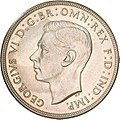 | 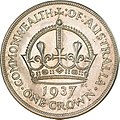 | Crown (5/-) | 38.5 mm | 28.27 g | Sterling silver (92.5% silver, 7.5% copper) | Portrait of King George VI. Designed by Thomas H. Paget. | At centre the Imperial crown with the date below, "COMMONWEALTH OF AUSTRALIA" above, "ONE CROWN" below. Designed by George Kruger Gray. | 1937 | 1937–1938 |
| These images are to scale at 2.5 pixels per millimetre. For table standards, see the coin specification table. |






































